
Fight or Fright
A Preview of Battles and Traps in Winter Tales
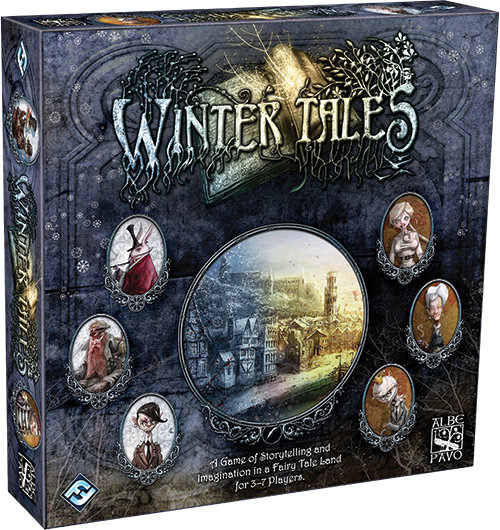
The Mad Hatter pulled his frock coat tight across his shoulders as he shivered on the corner of the block. He didn’t need to be out here guarding the regime. He had patients in his asylum, patients who desperately needed his help. A familiar figure walked by, still wearing a straitjacket, and the Hatter snapped out of his reverie. Alice had rejected the beneficial effects of his electroshock therapy, and she was clearly a danger to the public. He drew scalpel and hook from his pocket and dashed after her, steeling himself for battle.
Winter Tales is a new board game of imaginative storytelling for three to seven players, set in the fairy-tale region of Wintertown. Both the regime of winter and the spring rebels struggle to tip the balance of power in their favor. You must lead your characters to victory in an ongoing tale of adventure and destiny, creating a new story with every game. A detailed overview of gameplay in Winter Tales can be found on the game’s description page or in our last preview, where we covered the basics of movement and questing as well as the importance of story cards.
Today, we’ll uncover different ways for you to foil your opponents’ plans by using story cards to engage in battle and spring traps!
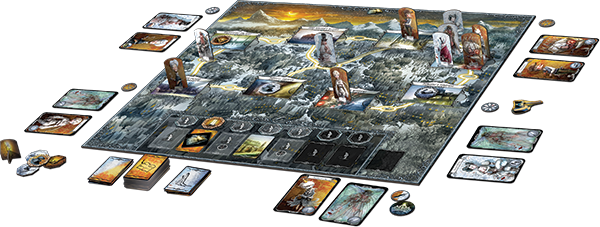
Stand and Fight!
As you move your character through the crowded streets of Wintertown, you’re certain to cross paths with characters from the opposing faction. Sometimes, movement can prove risky. When a rebel moves into a space containing a winter soldier, the soldier has the opportunity to declare that he is battling the unfortunate rebel who dared cross his path. In a battle, you and your opponent alternate playing story cards, expanding the story of the battle between your characters.
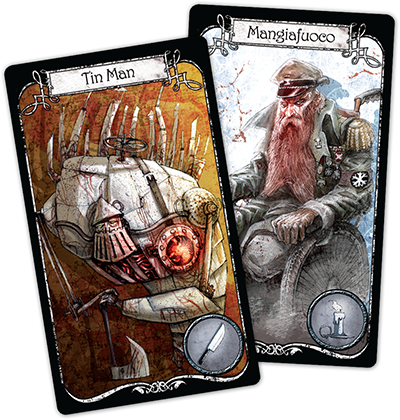
For example, a spring player might intend to move Tin Man from Memory Lane Cemetery to the Fair of Wonders. If you have a soldier in Tin Man’s path, however, you may draw Tin Man into a battle with your soldier. In our example, Tin Man has been halted and embattled by Mangiafuoco, the tyrannical dictator of Wintertown. As the winter player, you begin the battle and the story of the fight by playing a story card from your hand and saying, “Mangiafuoco sees Tin Man, a confirmed rebel, creaking towards the Fair of Wonders. Mangiafuoco knows Tin Man is trying to undermine his power, so he pulls out his gun and fires, making bullet holes in Tin Man’s armor.”
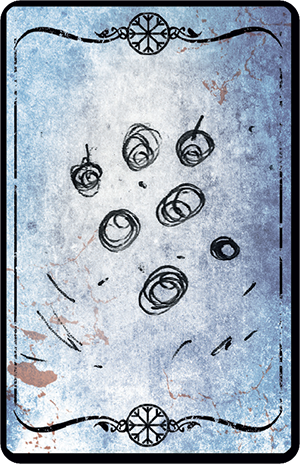 After you play a story card, the spring player has the chance to play his own card and turn the battle in his favor. The spring player controlling Tin Man plays a story card and says, “The Tin Man pulls a small box from his belt and throws it on the ground, creating a thick cloud of smoke. He tries to escape under cover of the distraction.” Since the spring player has played a story card in the battle, you now have the option to break off the attack or continue the battle by playing more story cards.
After you play a story card, the spring player has the chance to play his own card and turn the battle in his favor. The spring player controlling Tin Man plays a story card and says, “The Tin Man pulls a small box from his belt and throws it on the ground, creating a thick cloud of smoke. He tries to escape under cover of the distraction.” Since the spring player has played a story card in the battle, you now have the option to break off the attack or continue the battle by playing more story cards.
You and your opponent take turns in a battle, moving back and forth and chronicling the saga of your struggle. When one player stops playing cards, the victor is the player who played the most recent story card. This player must resolve the plot of the battle, explaining how he came to win. In the example, Mangiafuoco couldn’t see through the cloud of smoke, but he was able to defeat Tin Man by setting the buildings of the square on fire and waiting at the exit. Because Tin Man lost the battle, he cannot continue his movement and becomes incapacitated. When one of your characters is incapacitated, that character cannot move, activate, or take any actions until you or another character discards two story cards and uses them to tell the story of how your character was saved.
Lie in Wait…
The soldiers of winter are strong in the streets and squares of Wintertown, but they can be trapped by the rebels if they are foolish enough to enter rebel locations unprepared. When a soldier moves into the same location as a rebel, the rebel has the opportunity to declare that he is trapping the soldier.
 In order to lay a trap, you must first choose a story card that represents the trap: for example, a beaker filled with a powerful sleeping draught. Then, you secretly bid a number of story cards to represent the strength of the trap. After you have decided the trap’s strength, your opponent has the opportunity to attempt to break free by playing story cards from his hand and telling the story of his character’s efforts to avoid the snare.
In order to lay a trap, you must first choose a story card that represents the trap: for example, a beaker filled with a powerful sleeping draught. Then, you secretly bid a number of story cards to represent the strength of the trap. After you have decided the trap’s strength, your opponent has the opportunity to attempt to break free by playing story cards from his hand and telling the story of his character’s efforts to avoid the snare.
Once the winter player finishes playing cards, the strength of the trap is revealed. If the trap has more story cards than the winter player used, you have successfully trapped the soldier, and you conclude the episode of the trap by telling how the soldier fell into your devious trap. If the winter player played more cards than the strength of your trap, however, he concludes the story by explaining how he bested your efforts.
By successfully trapping a soldier of winter, the rebels can incapacitate a soldier, keeping them immobile and ineffective until he is saved. Traps can serve another function as well, however. Because the strength of your trap is unknown, the winter player cannot know exactly how many cards he must play to break free. By intentionally creating a weak trap, you have the chance to fool the winter player into wasting story cards, leaving him defenseless in the face of future events.
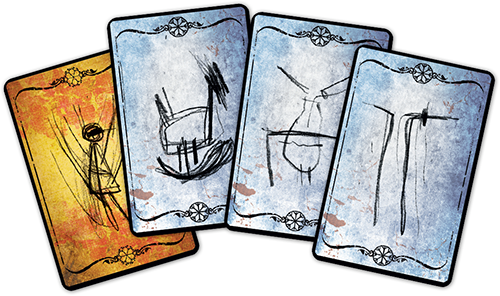
The Story Continues
Battles and traps are just a few of the stories that are created within the larger narrative of every game of Winter Tales. You must quest vigorously and incapacitate your opponents if you wish your season to thrive and triumph.
In our next preview, we’ll examine the Memory Track and the Epilogue, as we illustrate the importance of completed quests and the finale at the end of the game. Keep checking back for more previews as the release date draws closer, and pre-order Winter Tales at your local retailer today!
…
